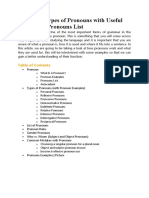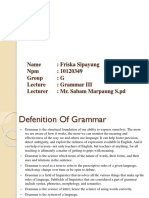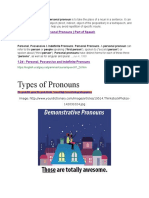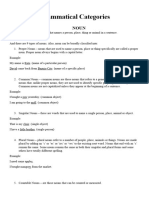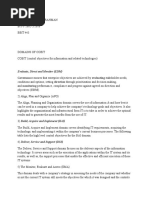Intensive Pronoun
Intensive Pronoun
Uploaded by
amanda salsaCopyright:
Available Formats
Intensive Pronoun
Intensive Pronoun
Uploaded by
amanda salsaCopyright
Available Formats
Share this document
Did you find this document useful?
Is this content inappropriate?
Copyright:
Available Formats
Intensive Pronoun
Intensive Pronoun
Uploaded by
amanda salsaCopyright:
Available Formats
What is an intensive pronoun?
An intensive pronoun is a pronoun that refers back to the subject of a sentence in order to
emphasize it. For example, the pronoun himself is an intensive pronoun in the sentence The
detective himself was the culprit. The pronoun himself refers back to the subject the detective in
order to add emphasis. By using an intensive pronoun, the sentence highlights how unexpected it
is that a detective who is supposedly investigating a crime is actually the criminal. An intensive
pronoun often immediately follows the noun or pronoun it refers to, but this isn’t always the
case.
There are many different reasons why we would use intensive pronouns, such as to point out an
odd or unexpected situation or to highlight an impressive achievement.
The prime minister herself appeared at the rally. (Nobody expected the prime minister to
be there.)
The third-grader wrote the bestselling book themselves. (It is an impressive feat for a
young child to write a successful book.)
List of intensive pronouns
Depending on how many people an intensive pronoun refers to, it can be singular or plural. All
intensive pronouns end in either -self or -selves.
Singular intensive pronouns
An intensive pronoun is singular if it only refers to one person. Singular intensive pronouns
include:
myself
yourself
herself, himself, itself
Plural intensive pronouns
An intensive pronoun is plural if it refers to more than one person or thing. The most commonly
used plural intensive pronouns are:
ourselves
yourselves
themselves
Themself
The word themself is sometimes used in nonstandard English as a variant of the word themselves
or as an intensive version of the word they as a singular pronoun to neutrally refer to a person.
For example,
The people themself wanted a democracy. (Themself is used instead of themselves.)
The student made the project themself. (The student’s gender is unknown or not
relevant.)
However, the word themself is also used to refer to a person who identifies as nonbinary. Using
themself in this context is perfectly acceptable:
Gale themself paid for the party.
Examples of intensive pronouns
Let’s look at some examples of intensive pronouns used in sentences.
Singular intensive pronouns
I built this house myself.
You need to find the answer yourself.
It turned out that Abraham Lincoln himself had written the poem.
The band’s singer wrote all of the songs herself.
The mouse itself opened the door to the cage.
Plural intensive pronouns
We will have to escape the island ourselves.
You yourselves have the potential to accomplish anything.
It turned out that the gardeners themselves had taken the tractor.
Intensive pronouns vs. reflexive pronouns
Intensive pronouns are identical in form to another type of pronoun known as reflexive pronouns,
which also end in -self or -selves. However, these two types of pronouns serve different
grammatical functions.
As has been said, intensive pronouns are used to emphasize a subject by repeating it:
Gandhi himself was the author of the book. (We are emphasizing that Gandhi is the
author because it might be unexpected or newsworthy.)
Reflexive pronouns are used when the subject and object of a sentence are the same:
Julianna introduced herself to the class. (Julianna is both the subject and the object of the
sentence: Juliana introduced Juliana.)
Proper usage
Each intensive pronoun corresponds to a personal pronoun. The intensive pronoun refers to the
same person or thing that its personal pronoun does. Each of the commonly used intensive
pronouns are listed below:
myself: me (the speaker or the writer)
yourself: you as a singular (another single person besides the speaker/writer)
itself: it (a thing or an animal)
himself: him (a male person or animal)
herself: her (a female person or animal)
ourselves: us (the speaker/writer and other people together)
yourselves: you as a plural (other people besides the speaker/writer)
themselves: them (a group of people, animals, or objects)
themself: them as a singular (see the usage explanation above.)
How much do you know about possessive pronouns?
An intensive pronoun is not used by itself in a sentence. An intensive pronoun follows the
noun/pronoun it refers to, often immediately.
Incorrect: Himself solved the mystery. (Who?)
Correct: Dr. Watson himself solved the mystery.
Also correct: Dr. Watson solved the mystery himself.
If you are unsure which intensive pronoun to use, think about what the subject is and what
personal pronoun you would use if that subject were the object of the sentence:
The tiny hamster ____ gathered the leaves.
We know that the tiny hamster is the subject, but we don’t know which intensive pronoun to use.
To figure this out, let’s use the tiny hamster as an object in a different sentence and see which
personal pronoun we would use.
I fed cabbage to the tiny hamster.
I fed cabbage to it.
Because we would use it to refer to the tiny hamster, the correct intensive pronoun to use in our
original sentence is itself:
The tiny hamster itself gathered the leaves.
If we know what sex the hamster is, we could also use the gendered pronouns herself or himself
in this sentence as well:
The tiny hamster herself gathered the leaves.
You might also like
- Ntumwa William Moses LLB (Muk)Document126 pagesNtumwa William Moses LLB (Muk)ntumwawilliamNo ratings yet
- Reflexive PronounDocument5 pagesReflexive PronounAbdul HarisNo ratings yet
- Reflexive PronounDocument5 pagesReflexive Pronounamanda salsaNo ratings yet
- Pronouns WPS OfficeDocument21 pagesPronouns WPS OfficeYukino MichinariNo ratings yet
- N-P AgreementDocument12 pagesN-P AgreementDr. C. Jothi ENG-STAFFNo ratings yet
- When To Use Reflexive PronounsDocument11 pagesWhen To Use Reflexive PronounsAnonymous yWujJFg2XsNo ratings yet
- Week 3: Parts of Speech: PronounsDocument33 pagesWeek 3: Parts of Speech: PronounsVivian MwangiNo ratings yet
- What Is A Reflexive PronounDocument4 pagesWhat Is A Reflexive PronounRuthcie Mae D. LateNo ratings yet
- album about the types of pronounsDocument42 pagesalbum about the types of pronounsgdplexNo ratings yet
- 10 Kinds of Pronouns in EnglishDocument5 pages10 Kinds of Pronouns in EnglishRizal TambunanNo ratings yet
- Jeremy His (Jeremy's) : 1. Personal PronounsDocument9 pagesJeremy His (Jeremy's) : 1. Personal PronounsSanuNo ratings yet
- Types of Nouns: Demonstrative PronounsDocument12 pagesTypes of Nouns: Demonstrative Pronounsanon_132777102No ratings yet
- Chapter 19. Other PronounsDocument21 pagesChapter 19. Other PronounsNait ThorNo ratings yet
- What Are Reflexive PronounsDocument4 pagesWhat Are Reflexive Pronouns배BeaNo ratings yet
- 2 PronounsDocument4 pages2 PronounsValaNo ratings yet
- Lesson 1 PronounDocument6 pagesLesson 1 PronounZura KatsuraNo ratings yet
- Parts of SpeechDocument11 pagesParts of SpeechAyesha AsifNo ratings yet
- The Different Types of NounsDocument18 pagesThe Different Types of NounsL.a.ZumárragaNo ratings yet
- Reflexive and Intensive PronounsDocument4 pagesReflexive and Intensive PronounsmarkyNo ratings yet
- PronounsDocument10 pagesPronounskevin castilloNo ratings yet
- Pronoun ADocument5 pagesPronoun AsamanNo ratings yet
- Basic Business EnglishDocument15 pagesBasic Business EnglishPulkit RalhanNo ratings yet
- Pronouns 2Document9 pagesPronouns 2StevenCullenNo ratings yet
- Visita Iglesia PrayerDocument17 pagesVisita Iglesia Prayerwsx6xnsqxkNo ratings yet
- PronounsDocument4 pagesPronounspalomaresjay0No ratings yet
- Noun PhrasesDocument24 pagesNoun PhrasesFaiza ShafiqueNo ratings yet
- 5 Example of Intensive Pronoun in SentenceDocument2 pages5 Example of Intensive Pronoun in SentenceRaúl Javier Gambe CapoteNo ratings yet
- Pronoun - Types of Pronouns With Useful Examples - Pronouns ListDocument16 pagesPronoun - Types of Pronouns With Useful Examples - Pronouns ListAdelina Elena Ghiuţă100% (1)
- Types of PronounsDocument7 pagesTypes of PronounsYusuf SsessangaNo ratings yet
- The Tell-Tale Heart 0Document12 pagesThe Tell-Tale Heart 0Lore JimenezNo ratings yet
- Tarea - No. - 3 - %93Pronouns%3A - Emphatic - and - Reflexive%94 2Document10 pagesTarea - No. - 3 - %93Pronouns%3A - Emphatic - and - Reflexive%94 2ashvega1208No ratings yet
- Written Report in Teaching EnglishDocument5 pagesWritten Report in Teaching Englishhazel ann canejaNo ratings yet
- What Is A Reflexive PronounDocument3 pagesWhat Is A Reflexive Pronounerooz5804No ratings yet
- PronounDocument27 pagesPronounshekaba146No ratings yet
- Personal Pronouns: PronounDocument5 pagesPersonal Pronouns: PronounHARISH KUMAR SHARMA0% (1)
- PRONOUNDocument16 pagesPRONOUNNadiyaNo ratings yet
- PronounsDocument11 pagesPronounslujain.zak.lzNo ratings yet
- Maya Sukma (Kel. 4)Document4 pagesMaya Sukma (Kel. 4)Maya SukmaNo ratings yet
- Advanced Grammar PDFDocument27 pagesAdvanced Grammar PDFTherealpouyaNo ratings yet
- Grammar Friska SipayungDocument36 pagesGrammar Friska SipayungLesbra SandyNo ratings yet
- Reflexive Intensive PronounsDocument5 pagesReflexive Intensive PronounsRome Tancioco TayerNo ratings yet
- 10 Kinds of PronounsDocument3 pages10 Kinds of PronounsCOMPRA CLOVIN MARI P.No ratings yet
- The Boy Said That Was Tired. He: in This Example, The Pronoun "He" Is Refer-Ring Back To The Noun (Antecedent) "Boy."Document3 pagesThe Boy Said That Was Tired. He: in This Example, The Pronoun "He" Is Refer-Ring Back To The Noun (Antecedent) "Boy."YogiAfriYendraNo ratings yet
- PronounDocument16 pagesPronounJirayut HomkateNo ratings yet
- English Assignment 1Document22 pagesEnglish Assignment 1katilabbuNo ratings yet
- Bing Pronoun ErniDocument8 pagesBing Pronoun ErniwiraelvinNo ratings yet
- Class Material - PRONOUNS AND POSSESSIVES - Docx - 20240326 - 102643 - 0000Document4 pagesClass Material - PRONOUNS AND POSSESSIVES - Docx - 20240326 - 102643 - 0000hbibalafguirchNo ratings yet
- Pronoun Cases and Types English Composition 1Document5 pagesPronoun Cases and Types English Composition 1Helen ZakiNo ratings yet
- PRONOUNSDocument21 pagesPRONOUNSJoseph Christian TrinidadNo ratings yet
- PronounsDocument16 pagesPronounsfatimatuzahra503No ratings yet
- Complete Parts of Speech 247Document21 pagesComplete Parts of Speech 247Zabi MansooriNo ratings yet
- Reflexive and Intensive PronounsDocument6 pagesReflexive and Intensive PronounsStàllightNo ratings yet
- Grammarmodule.docx 1 1 2Document23 pagesGrammarmodule.docx 1 1 2jocelyn sanchezNo ratings yet
- Elp Prelim Learning Materials (1)Document27 pagesElp Prelim Learning Materials (1)augustinebrianpaulNo ratings yet
- Reflexive and EmphaticDocument5 pagesReflexive and EmphaticJason DeaibessNo ratings yet
- Parts of Speech: By: Tiyas Saputri, S.S., M.PDDocument41 pagesParts of Speech: By: Tiyas Saputri, S.S., M.PDDenna Refnaldi SatryaNo ratings yet
- Parts of SpeachDocument6 pagesParts of Speachnavadeep149No ratings yet
- M2 PronounDocument57 pagesM2 PronounR BeNo ratings yet
- Grammatical-Categories 2.5Document12 pagesGrammatical-Categories 2.5arl somarNo ratings yet
- Unit 3 C1 GrammarDocument17 pagesUnit 3 C1 Grammarshaimaa MantawyNo ratings yet
- 7 Days to Grammar Excellence: How to Master English from Beginner to AdvancedFrom Everand7 Days to Grammar Excellence: How to Master English from Beginner to AdvancedNo ratings yet
- Islamic Correspondence Course Advanced Book Two: Hujjatul Islam Wal Muslimeen Al-Haj Sayyid Muhammad RizviDocument79 pagesIslamic Correspondence Course Advanced Book Two: Hujjatul Islam Wal Muslimeen Al-Haj Sayyid Muhammad RizviMubahilaTV Books & Videos OnlineNo ratings yet
- IGCSE Global Perspectives Team Element - Traditions, Cultures, and IdentityDocument3 pagesIGCSE Global Perspectives Team Element - Traditions, Cultures, and IdentityICENo ratings yet
- Naskah DramaDocument5 pagesNaskah DramaMade WijayaNo ratings yet
- Evaluate, Direct and Monitor (EDM) : Evaluating Direction MonitoringDocument4 pagesEvaluate, Direct and Monitor (EDM) : Evaluating Direction MonitoringbrianNo ratings yet
- How Do You Keep Your Legs When You're Sitting Down? This Is What Your Sitting Posture Says About Your Personality!Document6 pagesHow Do You Keep Your Legs When You're Sitting Down? This Is What Your Sitting Posture Says About Your Personality!Joseph Bahian-AbangNo ratings yet
- Format For BlackbookDocument5 pagesFormat For BlackbookKaran MorbiaNo ratings yet
- Bisleri Brand DossierDocument46 pagesBisleri Brand DossierHarshit ParekhNo ratings yet
- SS1 GEO 3RD TERM WK1 Nigeria Location, Position and SizeDocument3 pagesSS1 GEO 3RD TERM WK1 Nigeria Location, Position and SizeTammy IbelemaNo ratings yet
- HIV/AIDS Awareness Evaluation in The Junior and Senior High School Students of University of The East Caloocan (UEC)Document11 pagesHIV/AIDS Awareness Evaluation in The Junior and Senior High School Students of University of The East Caloocan (UEC)Sebastian Miguel CarlosNo ratings yet
- Bent RuleDocument4 pagesBent RuleHARSHIT KHANNANo ratings yet
- Jio Final ThesisDocument77 pagesJio Final ThesisSuruchi GourNo ratings yet
- Arabian LiteratureDocument10 pagesArabian LiteratureDyann GarciaNo ratings yet
- Qualifications of DaiDocument9 pagesQualifications of DaialimasarratNo ratings yet
- Chemistry Summer AssignmentDocument20 pagesChemistry Summer AssignmentUsama TariqNo ratings yet
- Body Language Differences Between Men and WomenDocument2 pagesBody Language Differences Between Men and WomenMarion MardodajNo ratings yet
- Task 3 - New Year's ResolutionsDocument9 pagesTask 3 - New Year's Resolutionsvanesapereira825No ratings yet
- Bme SyllabusDocument2 pagesBme SyllabusAravind SaseendranNo ratings yet
- Prasna NotesDocument24 pagesPrasna NotesRajeswara Rao NidasanametlaNo ratings yet
- Mechanical Engineering Department: Ministry of Education and Culture Sriwijaya University Engineering FacultyDocument1 pageMechanical Engineering Department: Ministry of Education and Culture Sriwijaya University Engineering FacultympliosNo ratings yet
- Tru Identity AHW 2.1Document2 pagesTru Identity AHW 2.1Ekko KidzNo ratings yet
- 7.13 - Origins of Life On EarthDocument9 pages7.13 - Origins of Life On EarthBliss SinghalNo ratings yet
- ChinatownDocument8 pagesChinatownalixerlijNo ratings yet
- Punctuation Guide Modif. Sept. 2017Document14 pagesPunctuation Guide Modif. Sept. 2017Boris SalgeNo ratings yet
- Exer 2 BotanyDocument24 pagesExer 2 BotanyKwyn Evanne B. VeranoNo ratings yet
- Achievements of Fatima JinnahDocument5 pagesAchievements of Fatima Jinnahmuhammadrafay100% (1)
- Alyssa Particelli - Spongebob Genetics 1Document2 pagesAlyssa Particelli - Spongebob Genetics 1api-440360237No ratings yet
- Modals Chart 3º BilDocument7 pagesModals Chart 3º BilVictoria Toledo HernándezNo ratings yet
- The Eclipse Between The People of Faith and The People of NegligenceDocument12 pagesThe Eclipse Between The People of Faith and The People of NegligenceabdounouNo ratings yet
- The Reign of God in Mt. ZionDocument4 pagesThe Reign of God in Mt. ZionKingdom Teachings Shared By Apostle John EckhardtNo ratings yet



























